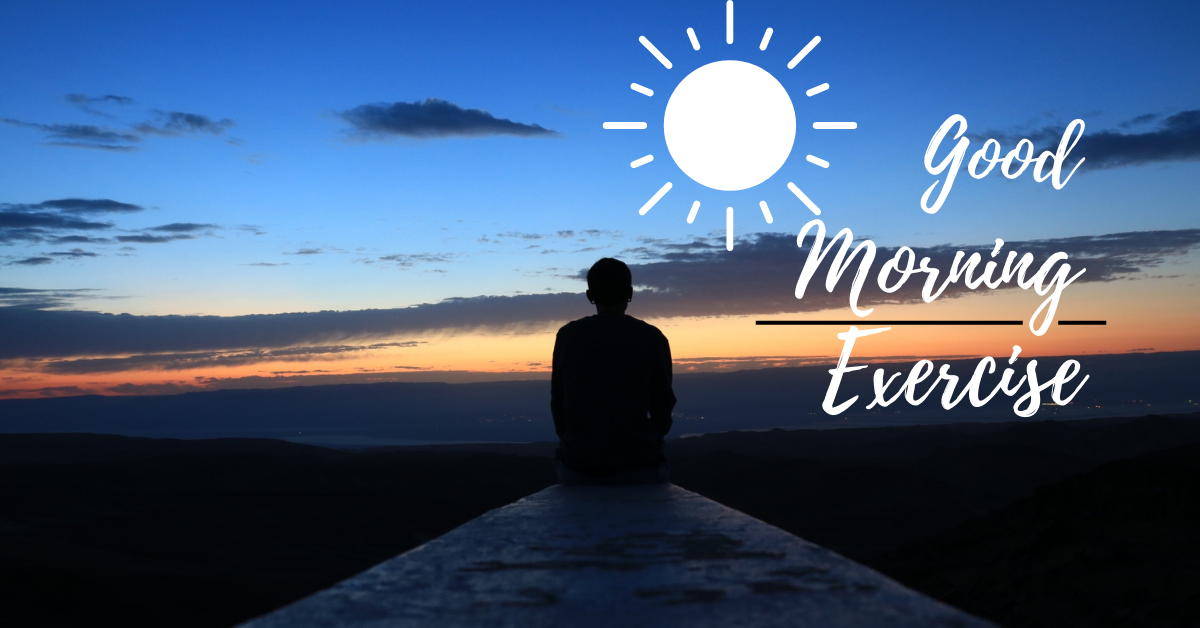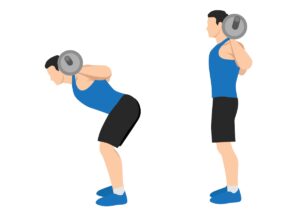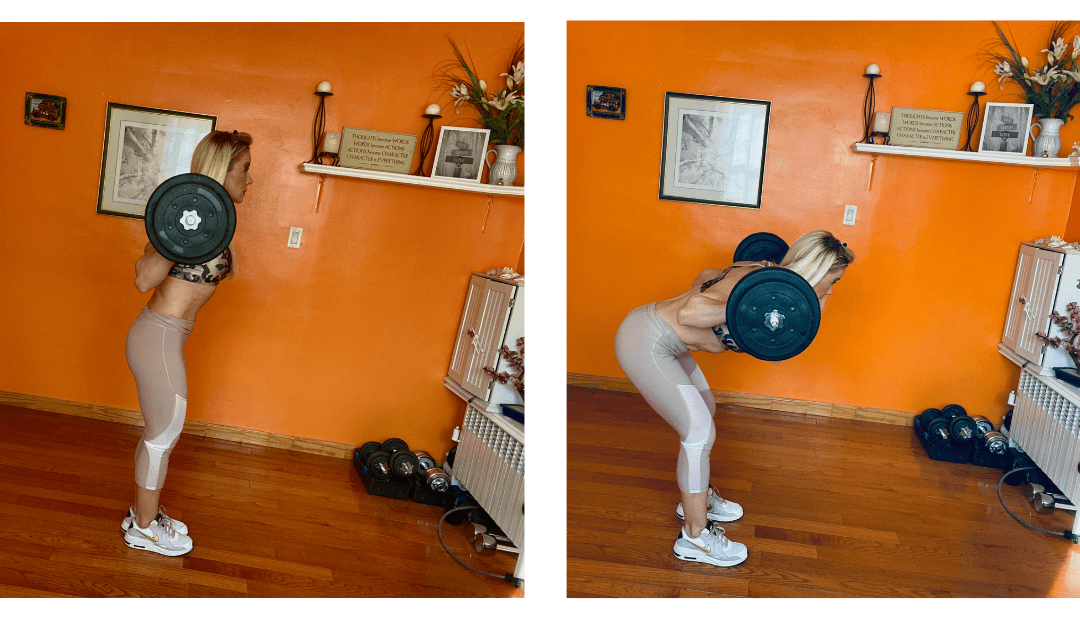There is a great exercise that is rarely performed but has numerous benefits. This is the good morning exercise. It targets several muscles in the posterior chain, muscles located in the posterior area of the upper and lower body. So start your day with good mornings!

Below we’ll look deeper into the good morning exercise and we’ll cover the following:
- Muscles involved in good mornings
- Benefits associated with the good morning exercise
- How to properly do good mornings
- Common mistakes when performing good mornings
- Video on how to do good mornings
- Exercises to complete your posterior chain workout
The good morning exercise is highly advantageous and resembles a polite bow or greeting, hence the name. The good morning works on a hinge pattern, creating hip extension and flexion. During the hinging motion, the targeted muscles are responsible for hip extension when eccentrically loaded.
What Muscles Do Good Mornings Work?
Primary muscles involved in good mornings:
- Gluteal muscles or Glutes: There are three muscles that make up the area of the buttocks: the gluteus maximus, gluteus medius, and gluteus minimus. They originate from the ilium and sacrum and insert into the femur. The gluteus maximus is the largest and most superficial of the three gluteal muscles and is responsible for the most part in the shape and appearance of the butt. It’s an extensor of the hip joint and assists in laterally rotating the thigh. The gluteus medius is the major abductor of the thigh, helping to rotate the hip medially and laterally. The gluteus minimus abducts and medially rotates the hip joint.
- Hamstrings: These muscles are located in the posterior area of the thigh, in between the hip and the knee. The semitendinosus, semimembranosus, biceps femoris long & short head flex (bend) the knee and extend (straighten) the hip – except the short head of biceps femoris. The hamstrings are in daily activities such as walking, running, and jumping.
- Erector Spinae (spinal erectors): These muscles run along more or less the length of the spine, from the sacrum and hips to the base of the skull, and make up most of the lower back. They straighten, rotate, and stabilize the back, and along with the glutes help maintain good posture. The spinalis muscle is the smallest and closest to the spine, the longissimus muscle is the intermediate and the largest of the three columns, and the iliocostalis is the outer muscle of the erector spinae.
Secondary muscles engaged:
- Abs (rectus abdominis): These are two parallel muscles, separated by a midline band of connective tissue (linea alba). They extend from the pubic area to the lower part of the sternum and ribs. The abs flex the lumbar spine, as when doing a crunch. They are also important for breathing, posture, and in creating intra-abdominal pressure – helping lift heavy objects and during childbirth and defecation.
- Rhomboids: These muscles are located in the upper back in between the scapula. They fix scapula to the thoracic wall, retract the scapula and rotate it to depress glenoid cavity. During good mornings, the upper back helps keep the back straight.
Good-Mornings Exercise Benefits
After looking at the muscles involved in good mornings, let’s understand all the benefits associated with the exercise:
- Fat Loss: This is a compound exercise that engages numerous muscle groups simultaneously, helping you to burn more fat.
- Lower Back Strength & Development: Good Mornings strengthen and sculpt the back, specifically the lower back.
- Back Health: Strengthening the back muscles keeps your back healthy. It helps to prevent injuries or pain, in dealing with back pain.
- Glute & Hamstring Development: Good mornings strengthen and nicely sculpt the glutes and the back of the legs.
- Improved Range of Motion: Hinging down, stretches your hamstring, glutes, and back, which helps improve the range of motion of your posterior chain muscles.
- Establish Proper Movement Patterns: Improving back stability under tension can help your technique during squats and deadlifts, as well as in other sport-related movements such as sprinting, jumping, and ball throwing.
- Aesthetics: Performing good mornings helps you sculpt beautiful glutes, hamstrings, and lower back muscles.
- Posture and Alignment: This exercise strengthens back, ab, gluteal muscles, and hip stabilizers which help you maintain an upright posture.
How to Do Good Mornings

-
Grab a barbell and place it across your back. You can use a low-bar position resting the bar across your rear delts (a bit safer) or a high-bar position across the trapezius muscles of the upper back, near your shoulders (which challenges the hamstrings and lower-back muscles a bit more).
- Stand with your feet shoulder-width apart, knees slightly bent.
-
Tighten your core, keep your back straight, grip the bar tightly, and get ready to break at your hips to initiate the movement.
-
Inhale as you hinge down. As you bend at the hips, press your hips back rather than simply leaning forward.
- Keep your spine and neck in alignment. Your head stays in a neutral position.
-
Bend your torso towards the floor until your torso is almost parallel to the floor. If you are tight, continue bending with your hips pressing back until your hamstrings begin to limit your movement or you feel the need to round your back or bend your knees to go deeper.
-
Hold for a second or two.
-
As you exhale, bring your torso back up to the starting position.
- Repeat the movement for 8 to 12-15 repetitions and for 3 sets.
You can vary the exercise by altering your stance. A wider stance engages more the hamstrings and adductors, while a narrower stance emphasizes the gluteal muscles more. You can also engage the lower back more with a deeper bend of the knees or when performing good mornings sitting down (as in a seated back extension).
Vary the set and repetition scheme according to your goals:
- If you want to build your posterior chain (back muscles, glutes, and hamstrings), do 3–5 sets of 8–12 repetitions.
- If you are looking for strength, you can go for lower reps but heavier weight, and do 3–5 sets of 3–5 repetitions. However, keep in mind that this exercise is not necessarily meant to be performed with super heavy weights.
Mistakes to Avoid
-
Bringing your torso lower than parallel to the ground: This can move the bar up toward the upper neck and overstress the neck and back.
-
Keeping the knees locked straight: Your knees should be slightly bent. Otherwise, you place too much stress on your lower back.
- Forcing the movement mechanics: You can go as low as the flexibility of your posterior chain muscles (hamstrings, glutes, and lower back) allows. Don’t push yourself too far too fast because you can really injure yourself.
- Rounding your back: Keep your back straight and engage your core. A straight back helps you maintain proper alignment and perform the exercise properly.
-
Poor form: It’s important to apply proper movement mechanics before using weights. Make sure you lift safely and you are performing the exercise with proper form so you effectively target the posterior chain and avoid injury.
-
Not warming up: Warming up is always important but much more during this exercise. This makes your muscles more flexible while supplying them with more oxygen. Otherwise, you risk straining your muscles and injuring yourself.
? It’s best to avoid using weights if you suffer from back or neck pain
Good-Morning Exercise Video:
Lower Back and Hamstring Workout
You can complete your posterior chain workout by performing the following exercises:
- Bent Over Underhand Barbell Rows
- Dumbbell Pullovers
- Lat Pulldowns
- Supermans
- Single-Leg Romanian Deadlifts
As you can see the good morning exercise is a wonderful exercise for the posterior chain muscles. It offers tremendous benefits associated with hypertrophy, strength, endurance, and aesthetics. Now that you know how to properly perform good mornings, you can avoid the most common mistakes and enjoy their benefits. Remember, whether you want to lose weight, tone your body, or gain strength or size, all muscles must be trained.
Lift, Burn more Fat, Get Stronger, and Live Healthier!
To a Fitter Healthier You,
The Fitness Wellness Mentor



